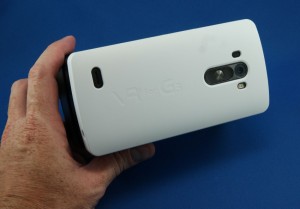VR for G3

The build of the VR for G3 takes advantage of the G3’s Quad HD display to create an immersive VR experience. The LG G3’s class-leading Quad HD display provides users with more pixels per inch creating sharper image quality for a more realistic VR experience.
viewer is broken up into three pieces, and they basically fit together like LEGO’s. You simply power on the G3 and place it in the front part of the viewer (the white piece) then snap the other two pieces into place and that’s all there is to it. The VR for G3 has no battery, but it also works quite differently than something like the Samsung Gear VR which draws power from the Note 4. With VR for G3 the unit doesn’t have to draw power so the only battery power being used up is for the G3 itself, which helps for longevity. There are slots on both sides where you can attach a headstrap if you wish, although the main design is meant just to hold. The sides of the headset also lets just a little bit of light in, so it feels slightly less immersive than the Gear VR. Just like with the Cardboard viewer there is a little round magnetic switch on the side you can pull down on to cycle through things, but before you can experience anything you’ll need to start with downloading some virtual reality enabled applications that work with the VR for G3.

Just like with Google Cardboard and other similar VR viewers/headsets, with the VR for G3 a good place to start is with the Cardboard app you can find in the Play Store, and this will be filled with some demos and other things to help showcase what is possible with the VR experiences from VR for G3, Cardboard and other VR viewers. It’s great for tech demos and to show family and friends what the unit can do, and kind of a cool little experience personally if you’ve never used anything that uses VR tech before. It’ll let you use Google Earth in 3D, and you can even view the photo sphere images within the Cardboard app as well. There are some full fledged VR apps though that aren’t all demos and they’re definitely worth looking into. Apps like VR Cinema for Cardboard which takes any MP4 video and turns it into a split-screen view for playback was pretty interesting and makes for a nice refreshing way to watch old videos in a new perspective. When it comes to applications, there are loads more than you might expect, and if you aren’t sure how to begin looking for them, simply open up the Cardboard app and it’ll prompt you to tap on a link to access more VR apps within the Play Store. You’ll do this before you place the phone inside of the VR for G3 viewer of course.

Using the VR for G3 is extremely simple. After you snap the phone into place and assemble the VR viewer, (you’ll want to open any apps you plan on using before you complete this step) looking around the room is all you have to do to place the cursor over what you want to access. It works well although it was a little jittery from time to time. As stated above using the little round magnet switch on the side by pulling down on it will let you select stuff. Since there is no back button here like with the Gear VR, exiting out to the main menu requires you to turn the headset vertically so the magnet on the left hand side faces up. You basically lift the headset away from your face and turn it upwards in an arc motion.
For more information visit: VR for G3 on LG’s Website.